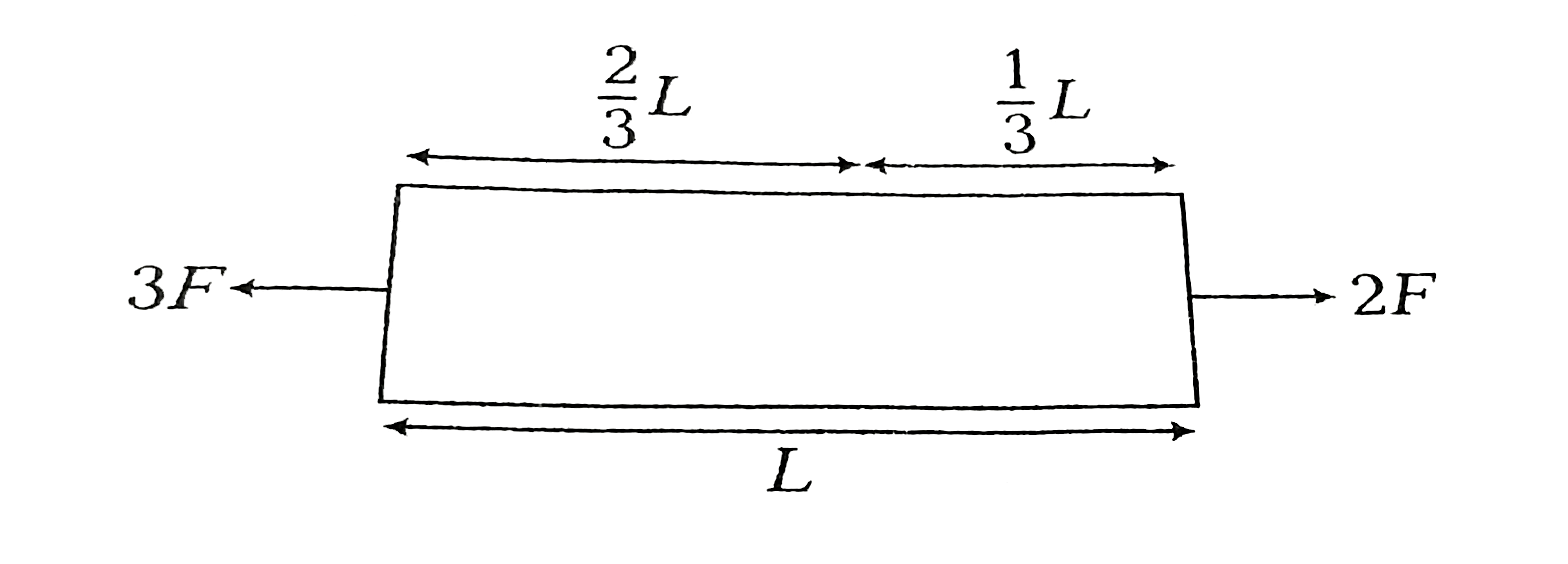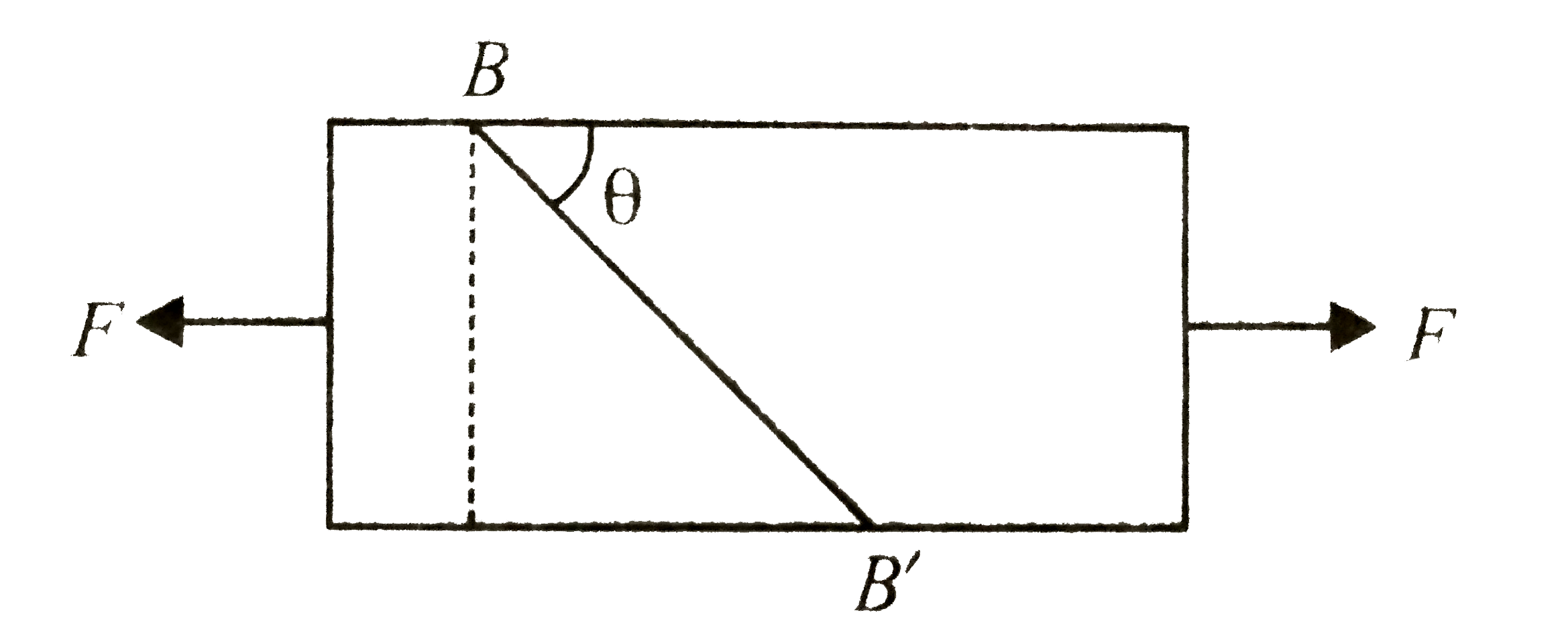The bar shown in the figure is made of a single piece of material. It is fixed at one end. It consists of two segments of equal lengh L/2 each but different cross sectional area A and 2A. Find the ratio of total elongation in the bar to the elongation produced in thicker segment under the action of an axial force F. Consider the shape of the joint to remain circular. (Given :Y is Young's modulus.
The correct Answer is:3
△L=F(L/2)AY=FL2AY
=△L2=F(L/2)2AY=FL4AY
Required ratio =△L1+△L2△L2=△L1△L2+1=2+1=3
Topper's Solved these Questions
- MISCELLANEOUS VOLUME 2BOOK - CENGAGE PHYSICSCHAPTER - MISCELLANEOUS VOLUME 2EXERCISE - LC_TYPE
34 Videos
- MISCELLANEOUS KINEMATICSBOOK - CENGAGE PHYSICSCHAPTER - MISCELLANEOUS KINEMATICSEXERCISE - Interger type
3 Videos
- NEWTON'S LAWS OF MOTION 1BOOK - CENGAGE PHYSICSCHAPTER - NEWTON'S LAWS OF MOTION 1EXERCISE - Integer
5 Videos
Similar Questions
A man standing on a inclined plain observes rain is falling verticaly. When he starts moving down the inclined plain with velocity v=6m/s observes rain hitting him horizontally.

The actual velocity of rain is
View SolutionA train is moving along a straight line with a constant acceleration 'a' . A boy standing in the train throws a ball forward with a speed of 10m/s, at an angle of 60(∘) to the horizontal. The boy has to move forward by 1.15m inside the train to catch the ball back at the initial height . the acceleration of the train , in m/s2 , is
View SolutionA block is placed on an inclined plane moving towards right horizontally with an acceleration a0=g. The length of the plane AC=1m. Friction is absent everywhere. Find the time taken (in seconds) by the block to reach from C to A.

View SolutionA steel rod of cross-sectional area 1m2 is acted upon by forces as shown in the Fig. Determine the total elongation of the bar. Take Y=2.0×1011N/m2

View SolutionA composite bar has two segments of equal length L each. Both segments are made of same material but cross sectional area of segment OB is twice that of OA. The bar is kept on a smooth table with the joint at the origin of the co - ordinate system attached to the table. Temperature of the composite bar is uniformly raised by Δθ. Calculate the x co-ordinate of the joint if coefficient of linear thermal expansion for the material is α∘C−1

View SolutionFind the total elongation of the bar, if the bar is subjected to axical froces as shown in figure . The cross-section area of bar is 10cm2 .
[TakeE=8×102dyne/cm2]

View SolutionA uniform cylindrical rod of length L and cross-sectional area by forces as shown in figure.

The elongation produced in the rod is
View SolutionThe bar shown in the figure is made of a single piece of material. It is fixed at one end and consists of two segments of equal length (L)/(2) but different cross-section area A and 2A. What is the change in length of the system under the action of an axial force F. [ consider the shape of joint to remain circular, Y is young's modulus] ltimg src="https://d10lpgp6xz60nq.cloudfront.net/physics_images/ALN_RACE_R64_E01_004_Q01.png" width="80%"gt
View SolutionA bar of mass M and length L is hanging from point S as shown in figure. The Young's modulus of elasticity of the wire is Y and the area of cross-section of the wire is A. (i) Find the stress at x distance from bottom end. (ii) Consider a samll section dx of the bar at a distance x from lowest point of bar. Find elongation (dL) in section dx. (iii) Find total elongation in bar. (iv) Find energy density at x distance from bottom and. (v) Find total elastic potential energy stored in bar.
View SolutionAn iron bar of length l cross section 'A' and young's modulus Y is pulled by a force F from both ends so as to produce an elongation 'e'. Which of the following statements is correct?
View SolutionTwo wires of different materials each of length l and cross sectional area 'A' are joined in series to form a composite wire. If their young's moduli are Y and 2Y, the total elongation produced by applying a force F to stretch the composite wire will be
View SolutionA bar is subjected lu axial forces as shown. is the modulus of elasticity of the bar is E and A is it cross-section area. Its elongation will be

View SolutionAn iron bar of length L, cross-section area A and Young's modulus Y is pulled by a force F from both ends so as to produce an elongation l . Which of the following statements is correct?
View SolutionA bar of cross- sectional area A is is subjected two equal and opposite tensile forces at its ends as shown in figure. Consider a plane BB' making an angle θ with length. The ratio of tensile stress to the shearing stress on the plane BB' is

View SolutionA steel rod of cross-sectional area 1m^(2) is acted upon by forces shown in the fig. Determine the total elongation of the bar. Take Y=2.0xx10^(11)N//m^(2) .
View Solution
